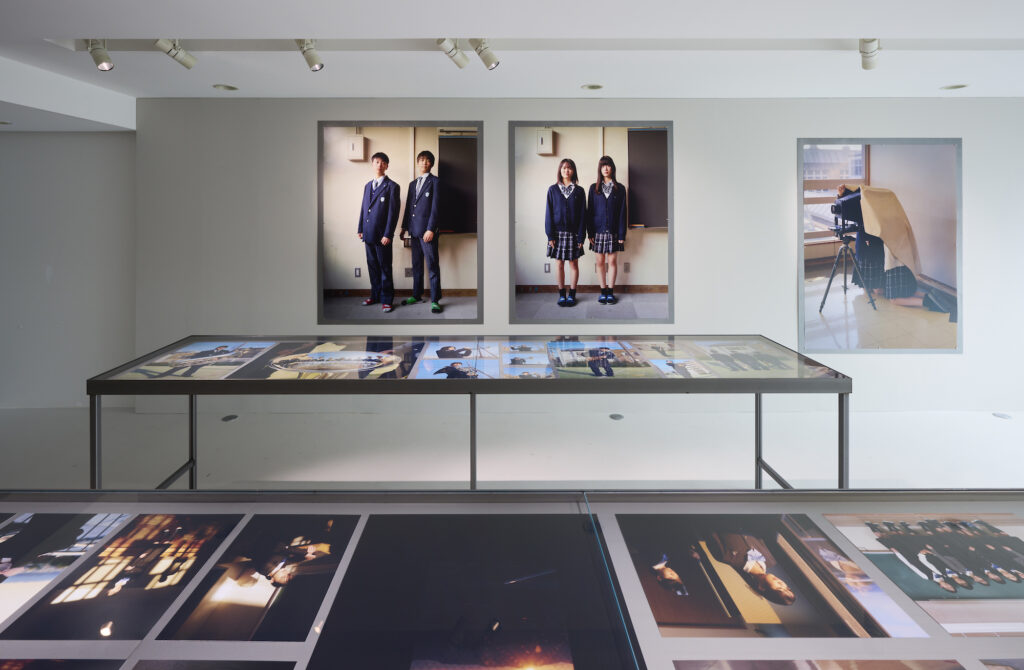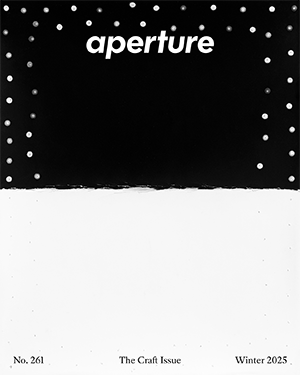Coco Capitán, from the series Ookini, 2022
The Spanish artist Coco Capitán has found inspiration in the sea and the color blue, out on the open landscapes of the American West, among a team of synchronized swimmers, and by revisiting a childhood vision of connecting Spain with China via a tunnel. The forms of her projects are equally multifarious, encompassing still photography, painting, and video, as well as aphoristic texts posing questions or fragments of thought, realized in what is now her signature scribbly handwriting. Capitán was recently a resident at Kyotographie, the annual photography festival in Kyoto. While there she created a series called Ookini (2022), Kansai for “thank you,” which considers young people in the city—the son of a kyōgen theater performer, Zen monk students, skaters, the daughters of a doll maker, a son from a family who for centuries has made tea kettles—who balance tradition, social expectations, and contemporary culture.

Michael Famighetti: How did you begin your new series, Ookini, which is made in Kyoto?
Coco Capitán: I had been traveling to Japan many times. For the longest time, I just dreamed of spending more time in Kyoto, working with young people there. But the city is kind of hard to access, in the sense that you cannot really photograph the people you want to photograph unless you have some sort of credential. It doesn’t need to be something so formal, but it’s more like you need to work with someone who lives in the city full time.
Famighetti: So, the local festival helped open some doors for you?
Capitán: The city is attached to tradition. I wanted to see how this is felt among the younger generations. In some ways, Kyoto can feel like it’s stuck in the past. There are these very strict customs and I was curious how they were felt by younger people—monks, skater kids, or high school students. The goal was to see very different characters in very different contexts, and to get a more general idea of how all these different teenagers with very different lives live in the same context, in a way.
Famighetti: With the young people who are studying to become monks, or with the young person from a family of tea kettle makers, are the kids involved in these traditions? Are they expected to carry them forward?
Capitán: I think there is a mix. There are teenagers who are more excited about it and others that jump into it because it’s a family obligation. In the case of the monks, almost all of the young monks I photographed have parents who are also monks. They are expected to become the same. There are actually more temples in Kyoto than there are monks. That’s one of the reasons why most sects are trying to recruit as many monks as possible. Each monk, once they finish their apprenticeship, is assigned a temple or shrine to care for.

Famighetti: Your project was split up amongst three spaces in Kyoto: a Zen temple, a museum, and a gallery space. How did you approach each presentation?
Capitán: My favorite was the installation in a temple, which included all of the monks’ photographs. We also had one day when the young monks came to see the show. There was also a video piece showing them doing their meditation and ceremonies. It was interesting to watch them watching themselves perform; in a way, being a monk is a performance. The master, or teacher, was there too, saying: “Oh, look at yourself. This is how . . . Guys, you’re making a mistake here. Or you could do it better there.” But they were really happy as well. They weren’t so obsessed with perfection. And it was really good.
All of the spaces in the temple open onto one rock garden. So we built these boxes to be placed on the tatami. Each box had a portrait of a monk meditating, and we placed them so they were all facing the garden, almost as if the monks themselves were looking at the garden, creating a dialogue between the outside and the inside. Of course, if you go into a traditional space, you might miss those elements. The monk running the temple introduced me to the student monks. The students would go to the temple sometimes, and when they came to see the show, they stayed there meditating during the evening session.


Famighetti: There is a sense of performance across the project, especially with the specific ways that people are dressed. It’s not a costume, but it’s often a uniform that comes with a set of codes or associations related to a role or social designation.
Capitán: I didn’t really ask for them to dress in a specific way, but I guess on many occasions it reflects the context of where the picture was made. The skater kids go skating after school, so that’s why they are all wearing school uniforms. When I was photographing the teens in the classrooms, they were at school, so they were also wearing school uniforms. And the monks, every day they have to wear these clothes when they are doing their rituals. In general, they were just dressed as they normally would. But in Japan, more than in many other places, uniforms are often used.

Famighetti: You’ve made a few projects in which you’re working outside of the culture that you come from. You did a project on the American West, another body of work was made in China. How do you negotiate your position as an outsider?
Capitán: It has its challenges, because you never want to be culturally appropriating anything or run into assumptions, just because you are external to that context. So that is something that is always pressing on my mind, and I try to look with a clear eye and not fall into stereotypes. There is always a difference when you go to a foreign space. First, there is the risk of idealizing the place. You create an idea based on the culture that you have consumed—films, literature. You create a version in your mind that is just a projection. The first time I was thinking a lot about this was actually with my project made in the United States.
Famighetti: Highway to Disappearance (2017)?
Capitán: Yes.


Famighetti: Many people only know the American West from cinema or literature. This mythology can be difficult to get away from. Photographers have to contend with an image bank of ingrained references.
Capitán: Totally. I was thinking a lot about Richard Prince and Marlboro advertising, and this idea, this mythology of the American Cowboy. I mean, it doesn’t exist now, and I don’t imagine it really ever existed in the way it has been portrayed in movies and advertising, or other forms of culture. I think when you look at something with the eyes of an outsider, you can observe many things that wouldn’t be so obvious to the people who belong to that culture. I’ve been considering photographing in Spain and Spanish traditions, and I think I will do it at some point. But the reason why it’s less attractive to me is because it’s so close. But it’s a very delicate arena.
Famighetti: I’m curious about your relationship with text and image. You also have a practice as a writer, and you’ve made books of short handwritten phrases, questions, and statements. How does that connect to your thinking on photography?
Capitán: Well, I feel that writing has always been my primary form of art. Everything I photograph, everything I paint is normally a reflection on something I have written about beforehand. Writing just comes very naturally to me. It’s something I do for myself—I never really thought of making an art form out of my writing. It was almost an accident. People started to pay attention to what I was writing. My friends always saw me walking around with my notebooks. I started to share some of these writings, but I never thought, Oh, this is going to be the art, or that this would be a statement on its own.
In relation to writing and photography, it goes two ways. There may be something that images have captured, and I feel the need to add some writing; and then there’s the other way around, sometimes writing is not enough to capture a specific feeling. I also enjoy giving titles to my photographs. You can name a photograph in two different ways, and it will have two completely different meanings.

Famighetti: You mentioned notebooks, but you’ve also made a few publications of your work. How do you view the book format?
Capitán: The book is the most important form. And I do very much enjoy exhibitions and installations. When it comes to actually producing a picture for a gallery space, what I enjoy about it is, of course, the photograph as an object. I print everything in the darkroom. We are used to seeing everything on our screens nowadays, and I think a lot is lost from photography as an object and all the choices of presentation—paper, printing process, framing, glass, no glass.
But books allow for story building. It’s where you can really control your narrative, because there is a beginning and an end. The way you tell a story in photography is all about sequencing. I feel like I’m writing with my photographs.
Famighetti: Did you find any good books while working in Kyoto? There are excellent bookshops there.
Capitán: Yeah. But I have a book dealer in Tokyo who gets me most of my books. One of my favorites is Chewing Gum and Chocolate (Aperture, 2014) by Shōmei Tōmatsu.
Famighetti: In Japan, the history of photography is so much a history of book publications, more than an exhibition history.
Capitán: I think for me the most important part is the book, because documentation and archiving in photography are so important. It’s fifty percent of the piece itself. Of course, you take installation photographs of exhibitions, but it is something that disappears. After the pictures of Kyoto are taken down, especially the ones in the beautiful spaces, you won’t be able to experience it ever again. But if I am making a book, anyone who is willing to open the book in the future will see exactly what I created in the way it was meant to be seen.

© the artist
Famighetti: In addition to working across media, you also work across photographic contexts and have collaborated with a number of brands. How do you balance your artistic practice with work for fashion brands, like Gucci?
Capitán: I’m very open about my practice in all senses. The art world creates a difference between fine art and commercial art, and perhaps sees one of lesser value. I don’t agree with such divisions. I think that in the past, when you think of the Renaissance, for example, all the art that was being made then, now considered to be the highest form of art, was commissioned.
I moved to London when I was eighteen, and I was broke. If I hadn’t worked commercially, I couldn’t possibly have worked for small magazines and had other opportunities. The important thing is to not get completely lost doing commercial assignments, and really balance them with your other work. Think, Is there any value in doing this project? Can I learn something? Can I offer something in return? I work a lot with Gucci, and made many text works with them, and a series of murals. For me, that was an amazing opportunity to have a voice in a more mainstream context. You’re part of pop culture.
Famighetti: The platform there is gigantic.
Capitán: I went to the Royal College of Art, London, which is a more traditional institution, to do my master’s, and I was sometimes, not necessarily criticized, but questioned for my commercial art. And the reality was if I didn’t work commercially, I wouldn’t even be able to be studying at this very posh and expensive school. That’s the reality that is ignored many times.
There are certain brands I will not collaborate with in certain contexts because it doesn’t seem aligned with my own philosophy and way of seeing the work. But as far as I am able to be honest with myself about it, I think it’s a good thing to do. I think it’s very boring to simply limit yourself and only think of “fine art” in a gallery as the highest form of art. It’s a little bit snobbish. I don’t know. I just think that making and considering and creating is always good versus not doing things. Maybe sometimes it’s about being able to look at it from a different point of view—or to play with the system and learn from it as well.
Coco Capitán’s work was displayed as a part of Kyotographie 2023, which was on view at multiple locations in Kyoto, Japan, from April 15 to May 14, 2023.


























